
Formidable was an ironclad barbette ship built for the French Navy between her keel laying in late 1879 and her completion in early 1889. She was the second and final member of the Amiral Baudin class. The ships of the class was designed in response to Italian naval expansion, and carried a main battery of three 370 mm (14.6 in) guns all mounted in open barbettes on the centerline. The armament was chosen after public pressure to compete with the very large guns mounted on the latest Italian ironclads.

Carnot was a pre-dreadnought battleship of the French Navy. She was laid down in July 1891, launched in July 1894, and completed in July 1897. She was a member of a group of five broadly similar battleships, along with Charles Martel, Jauréguiberry, Bouvet, and Masséna, which were ordered in response to the British Royal Sovereign class. Like her half-sisters, she was armed with a main battery of two 305 mm (12 in) guns and two 274 mm (10.8 in) guns in individual turrets. She had a top speed of 17.8 knots.
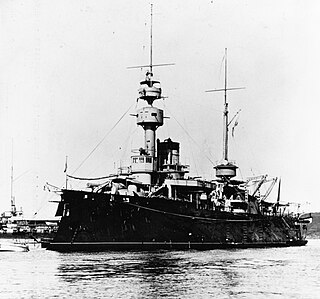
Amiral Baudin was an ironclad barbette ship of the French Navy built in the late 1870s and 1880s. She was the lead ship of the Amiral Baudin class, which included one other vessel, Formidable. The Amiral Baudin class was designed in response to Italian naval expansion, and carried a main battery of three 370 mm (14.6 in) guns all mounted in open barbettes on the centerline. The armament was chosen after public pressure to compete with the very large guns mounted on the latest Italian ironclads. Amiral Baudin was laid down in 1879 and was completed in 1888.

Hoche was an ironclad battleship built as a hybrid barbette–turret ship for the French Navy in the 1880s. Originally designed in response to very large Italian ironclads along the lines of the French Amiral Baudin class, by the time work on Hoche began, changes in French design philosophy led to a radical re-design that provided the basis for a generation of French capital ships. Her armament was reduced in size compared to the Amiral Baudins, and was placed in the lozenge arrangement that would be used for most French capital ships into the 1890s. Hoche suffered from serious stability problems that resulted from her large superstructure and low freeboard, which required extensive work later in her career to correct. The ship incorporated new technologies for the French Navy, including gun turrets for some of her main battery guns and compound armor plate.

Amiral Duperré was an ironclad barbette ship built for the French Navy in the 1870s and 1880s; she was the first vessel of that type built by France. She carried her main battery of four 34 cm (13.4 in) guns individually in open barbette mountings, which offered increased fields of fire compared to earlier central battery ships, though they were less well protected. Amiral Duperré was ordered as part of a French naval construction program aimed at countering the growth of the Italian fleet, which had begun work on the very large ironclads of the Duilio and Italia classes in the early 1870s. The Italian vessels, armed with 45 cm (17.7 in) guns, prompted public outcry in France that pressured the navy to develop larger guns for its own ships. Amiral Duperré's design served as the basis for several follow-on classes, including the Bayard and Amiral Baudin classes.

Châteaurenault was a large protected cruiser built for the French Navy in the late 1890s and early 1900s. She was intended to serve as a long-range commerce raider, designed according to the theories of the Jeune École, which favored a strategy of attacking Britain's extensive merchant shipping network instead of engaging in an expensive naval arms race with the Royal Navy. As such, Châteaurenault was built with a relatively light armament of just eight medium-caliber guns, but was given a long cruising range and the appearance of a large passenger liner, which would help her to evade detection while raiding merchant shipping.

D'Estrées was the lead ship of her class of protected cruisers built for the French Navy in the late 1890s. The class was ordered as part of a construction program directed at strengthening the fleet's cruiser force at a time the country was concerned with the growing naval threat of the Italian and German fleets, and were intended to serve overseas in the French colonial empire. D'Estrées was armed with a main battery of two 138 mm (5.4 in) guns, was protected by an armor deck that was 38 to 43 mm thick, and was capable of steaming at a top speed of up to 20 to 20.5 knots.
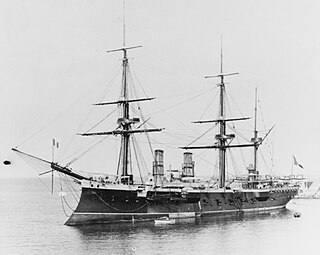
Sfax was a protected cruiser built for the French Navy in the 1880s. She was the first vessel of the type to be built for the French Navy, which was a development from earlier unprotected cruisers like Milan. Unlike the earlier vessels, Sfax carried an armor deck that covered her propulsion machinery and ammunition magazines. Intended to be used as a commerce raider in the event of war with Great Britain, Sfax was rigged as a barque to supplement her engines on long voyages abroad. She was armed with a main battery of six 164 mm (6.5 in) guns and a variety of lighter weapons.

Davout was a protected cruiser of the French Navy that was built in the late 1880s and early 1890s. The ship was ordered during the tenure of Admiral Théophile Aube as the French Minister of Marine, who favored a fleet centered on large numbers of cruisers of various types. Davout and the similar vessel Suchet were ordered to fill the role of a medium cruiser in Aube's plans. Davout was armed with a main battery of six 164 mm (6.5 in) guns in single mounts, and she had a top speed of 20.7 knots.
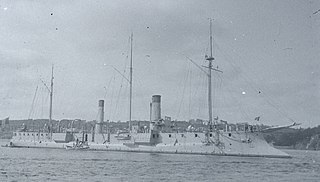
Surcouf was the second Forbin-class protected cruiser built for the French Navy in the late 1880s and early 1890s. The Forbin-class cruisers were built as part of a construction program intended to provide scouts for the main battle fleet. They were based on the earlier unprotected cruiser Milan, with the addition of an armor deck to improve their usefulness in battle. They had a high top speed for the time, at around 20 knots, and they carried a main battery of four 138 mm (5.4 in) guns.
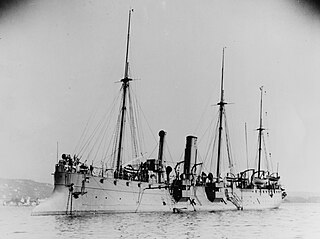
Lalande was a protected cruiser of the Troude class built for the French Navy in the late 1880s and early 1890s. The class was built as part of a construction program intended to provide scouts for the main battle fleet. They were based on the preceding Forbin class, the primary improvement being the addition of armor to the conning tower. Lalande was built in the 1880s and was completed in late 1890. She was armed with a main battery of four 138 mm (5.4 in) guns, protected with an armor deck that was 41 mm (1.6 in) thick, and had a top speed of 20.5 knots.

Cosmao was the third and final member of the Troude class of protected cruisers built for the French Navy in the late 1880s and early 1890s. The class was built as part of a construction program intended to provide scouts for the main battle fleet. They were based on the preceding Forbin class, the primary improvement being the addition of armor to the conning tower. Cosmao was built in the 1880s and was completed in 1890. She was armed with a main battery of four 138 mm (5.4 in) guns, protected with an armor deck that was 41 mm (1.6 in) thick, and had a top speed of 20.5 knots.

Alger was the sole member of her class of protected cruiser built for the French Navy in the late 1880s and early 1890s. Alger was ordered during the tenure of Admiral Théophile Aube as Minister of Marine according to the theories of the Jeune École doctrine. The ship was intended as a long-range commerce raider, and she was armed with a main battery of four 164 mm (6.5 in) guns, was protected by an armor deck that was 50 to 100 mm thick, and was capable of steaming at a top speed of 19.5 knots.

Friant was a protected cruiser of the French Navy built in the 1890s, and the lead ship of the Friant class. Friant and her two sister ships were ordered as part of a major construction program directed against France's Italian and German opponents in the Triple Alliance, and they were intended to serve with the main fleet, and overseas in the French colonial empire. They were armed with a main battery of six 164 mm (6.5 in) guns and had a top speed of 18.7 knots.
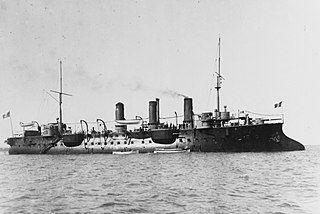
Bugeaud was a Friant-class protected cruiser of the French Navy built in the 1890s, the second of three ships of the class. The Friant-class cruisers were ordered as part of a construction program directed at strengthening the fleet's cruiser force. At the time, France was concerned with the growing naval threat of the Italian and German fleets, and the new cruisers were intended to serve with the main fleet, and overseas in the French colonial empire. Bugeaud and her two sister ships were armed with a main battery of six 164 mm (6.5 in) guns, were protected by an armor deck that was 30 to 80 mm thick, and were capable of steaming at a top speed of 18.7 knots.

Descartes was the lead ship of the Descartes class of protected cruisers built for the French Navy in the 1890s. The Descartes-class cruisers were ordered as part of a construction program directed at strengthening the fleet's cruiser force. At the time, France was concerned with the growing naval threat of the Italian and German fleets, and the new cruisers were intended to serve with the main fleet, and overseas in the French colonial empire. Descartes was armed with a main battery of four 164.7 mm (6.5 in) guns, was protected by an armor deck that was 20 to 40 mm thick, and was capable of steaming at a top speed of 19 knots.

D'Assas was the lead ship of her class of protected cruisers built for the French Navy in the 1890s. The D'Assas-class cruisers were ordered as part of a construction program directed at strengthening the fleet's cruiser force. At the time, France was concerned with the growing naval threat of the Italian and German fleets, and the new cruisers were intended to serve with the main fleet, and overseas in the French colonial empire. D'Assas was armed with a main battery of six 164 mm (6.5 in) guns, was protected by an armor deck that was 70 to 80 mm thick, and was capable of steaming at a top speed of 20 knots.

D'Iberville was the lead ship of the D'Iberville class of torpedo cruisers built for the French Navy in the 1890s. The class is also sometimes classified as torpedo gunboats or torpedo avisos. The D'Iberville-class ships were a development of earlier torpedo cruisers, with the chief improvement being a significantly higher speed. D'Iberville was armed with six 450 mm (17.7 in) torpedo tubes and a single 100 mm (3.9 in) gun as her primary offensive armament, though she had all of her torpedo tubes removed in 1896, just two years after entering service.

Cassini was the second member of the D'Iberville class of torpedo cruisers built for the French Navy in the 1890s. The class is also sometimes classified as torpedo gunboats or torpedo avisos. The D'Iberville-class ships were a development of earlier torpedo cruisers, with the chief improvement being a significantly higher speed. Cassini was armed with three 450 mm (17.7 in) torpedo tubes and a single 100 mm (3.9 in) gun as her primary offensive armament.
























